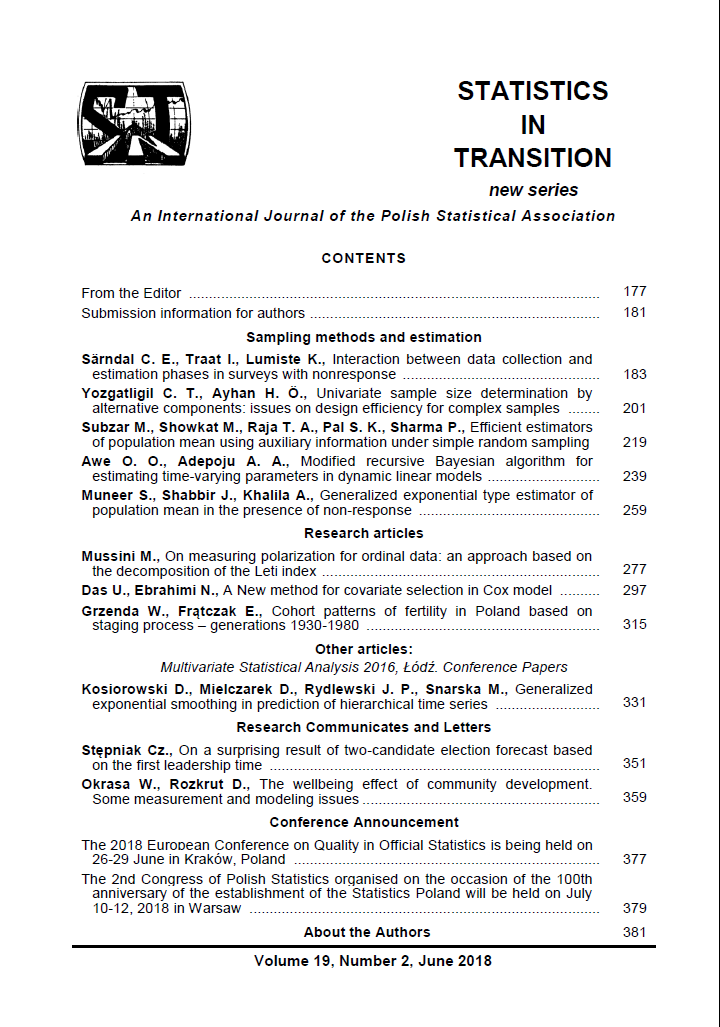ARTICLE
ABSTRACT
Inference in surveys with nonresponse has been studied extensively in the literature with a focus on the estimation phase. Propensity weighting and calibrated weighting are among the adjustment methods used to reduce the nonresponse bias. The data collection phase has come into focus more recently; the literature on adaptive survey design emphasizes representativeness and degree of balance as desirable properties of the response obtained from a probability sample. We take an integrated view where data collection and estimation are considered together. For a chosen auxiliary vector, we define the concepts incidence and inverse incidence and show their properties and relationship. As we show, incidences are used in balancing the response in data collection; the inverse incidences are important for weighting adjustment in the estimation.
KEYWORDS
adaptive survey design, auxiliary vector, incidence, inverse incidence, nonresponse adjustment, response imbalance.
REFERENCES
BEAUMONT, J. F., (2005). On the use of data collection process information for the treatment of unit nonresponse through weight adjustment. Survey Methodology, 31, pp. 227–231.
BETHLEHEM, J. G., (1988). Reduction of nonresponse bias through regression estimation. Journal of Official Statistics, 4, pp. 251–260.
BETHLEHEM, J. G., COBBEN, F., SCHOUTEN, B., (2011). Handbook on Nonresponse in Household Surveys. New York: Wiley.
BREIDT, F. J., CLAESKENS, G., OPSOMER, J. D., (2005). Model-assisted estimation for complex surveys using penalised splines. Biometrika, 92 (4), pp. 831–846.
BREIDT, F. J., OPSOMER, J. D., (2000). Local polynomial regression estimators in survey sampling. Annals of Statistics, 28 (4), pp. 1026–1053.
BRICK, J. M., (2013). Unit nonresponse and weighting adjustments: A critical review. Journal of Official Statistics, 29 (3), pp. 329–353.
BRICK, J. M., JONES, M. E., (2008). Propensity to respond and nonresponse bias. Metron, 66 (1), pp. 51–73.
CASSEL, C., SÄRNDAL, C. E., WRETMAN, J., (1983). Some uses of strategical models in connection with the nonresponse problem. In: Incomplete Data in Sample Surveys, ed. By W. G. Madow and I.Olkin, Vol. 3, New York: Academic Press.
CHAMBERS, R. L., CLARK, R. G., (2012). An Introduction to Model-Based Survey Sampling with Applications. Oxford University Press.
CHANG, T., KOTT, P. E., (2008). Using calibration weighting to adjust for nonresponse under a plausible model. Biometrika, 95 (3), pp. 555–571.
DEVILLE, J. C., (1998). La correction de la non-réponse par calage ou par échantillonnage équilibré. Paper presented at Congres de l’ACFAS, Sherbrooke, Québec.
DEVILLE, J. C., SÄRNDAL, C. E., (1992). Calibration estimation in survey sampling. Journal of the American Statistical Association, 87 (418), pp. 375–382.
ESTEVAO, V., SÄRNDAL, C. E., (2000). A functional form approach to calibration. Journal of Official Statistics, 16, pp. 379–399.
FOLSOM, R. E., SINGH, A. C., (2000). The generalized exponential model for sampling weight calibration for extreme values, nonresponse and poststratification. Proceedings, Section of Survey Research Methods, American Statistical Association, Washington DC, pp. 598–603.
FULLER, W. A., LOUGHIN, M. M., BAKER, H. D., (1994). Regression weighting in the presence of nonresponse with application to the 1987-1988 nationwide food consumption survey. Survey Methodology, 20, pp. 75–85.
KAMINSKA, O., (2013). Unit nonresponse and weighting adjustments: a critical review: discussion. Journal of Official Statistics, 29, pp. 355–358.
KOTT, P. S., CHANG, T., (2010). Using calibration weighting to adjust for nonignorable unit nonresponse. Journal of the American Statistical Association, 105 (491), pp. 1265–1276.
KOTT, P. S., LIAO, P., (2012). Providing double protection for unit nonresponse with a nonlinear calibration weighting. Survey Research Methods, 6 (2), pp. 105–111.
LITTLE, R. J. A., (2013). Discussion. Journal of Official Statistics, 29, pp. 363–366.
LITTLE, R. J. A., (1986). Survey nonresponse adjustments for estimates of means. International Statistical Review, 54 (2), pp. 139–157.
LUNDQUIST, P., SÄRNDAL, C.-E., (2013). Aspects of responsive design. With applications to the Swedish Living Conditions Survey. Journal of Official Statistics, 29, pp. 557–582.
MONTANARI, G. E., RANALLI, M. G., (2003). Nonparametric methods in survey sampling. In M. Vinci, P. Monari,, S. Mignani, A. Montanari (eds.), New Developments in Classification and Data Analysis. Berlin: Springer.
MONTANARI, G. E., RANALLI, M. G., (2005). Nonparametric model calibration estimation in survey sampling. Journal of the American Statistical Association, 100, pp. 1429–1442.
MONTANARI, G. F., RANALLI, M. G., (2012). Calibration inspired by semiparametric regression as a treatment for nonresponse. Journal of Official Statistics, 28, pp. 239–277.
OLSON, K., GROVES, R. M., (2012). An Examination of within-person variation in response propensity over the data collection field period. Journal of Official Statistics, 28, pp. 29–51.
POLITZ, A., SIMMONS, W., (1949). An attempt to get “Not at Homes” into the sample without callbacks. Journal of the American Statistical Association, 44 (245), pp. 9–31.
SÄRNDAL, C.-E., (2011). The 2010 Morris Hansen lecture: Dealing with survey nonresponse in data collection, in estimation. Journal of Official Statistics, 27, pp. 1–21.
SÄRNDAL, C.-E., LUMISTE, K., TRAAT, I., (2016). Reducing the response imbalance: Is the accuracy of the survey estimates improved? Survey Methodology, 42 (2), pp. 219–238.
SÄRNDAL, C.-E., LUNDSTRÖM, S., (2005). Estimation in Surveys with Nonresponse. New York: John Wiley& Sons, Inc.
SÄRNDAL, C.-E., LUNDQUIST, P., (2014). Accuracy in estimation with nonresponse: a function of degree of imbalance and degree of explanation. Journal of Survey Statistics and Methodology, 2, pp. 361–387.
SCHOUTEN, B., COBBEN, F., BETHLEHEM, J., (2009). Indicators for the repre sentativeness of survey response. Survey Methodology, 35, pp. 101–113.
SCHOUTEN, B., COBBEN, F., LUNDQUIST, P., WAGNER, J., (2016). Does more balanced survey response imply less non-response bias? Journal of the Royal Statistical Society, Series A, 179 (3), pp. 727–748.
SCHOUTEN, B., SHLOMO, N., SKINNER, C., (2011). Indicators for monitoring and improving representativeness of response. Journal of Official Statistics, 27, pp. 1–24.
TOURANGEAU, R., BRICK, J. M., LOHR, S., LI, J., (2017). Adaptive and responsive survey designs: a review and assessment. Journal of the Royal Statistical Society, Series A, 180 (1), pp. 201–223.
VALLIANT, R., DORFMAN, A. H., ROYALL, R. M., (2000). Finite Population Sampling and Inference: A Prediction Approach. New York: John Wiley & Sons Inc
